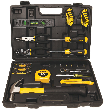Part of reducing interior noise levels lies in understanding where these noise levels come from. While it may be easy to say that they come from the television, radio, or even the kids, this isn't entirely correct. In large part, the design of the home plays a huge role in how noisy it is. The shapes, sizes, ceiling heights, and arrangement of the room and their contents can all greatly affect the way that noise acts in a home. Typically, there is little that can be done in this particular area to help in reducing interior noise other than rebuilding or substantially modifying the house.
It's not just the way that the house is designed though that can be blamed for interior noise levels, the other reason is actually sound. Simply put, sound can either be absorbed or reflected. In the cases of a home that is an echo chamber, there is little absorption, which in turn reduces interior noise levels. With homes that have large amounts of hard floors, or are designed in certain ways, there is generally a lot of reflection. This means that the sound persists and is echoed and transmitted throughout the home, room to room. Hence, a noise that is generated in one room, can easily be heard in all of the others.
If you have the money, a good engineer or contract or even an interior designer can take a look at such situations, appraise it, and deliver some recommendations. These recommendations can help to mitigate the problem, or even (if you are lucky) eliminate it. However, this option is generally very expensive, and one that should only be relied upon as a last resort.
For those that are faced with a home that has a lot of hard surfaces, and not a whole lot of money, there are a few options that you can use. The first thing to do is remember that angles and hard surfaces can often act like the cushions on a billiard table, which tends to "reflect" a billiard ball that hits them. The simplest solution is to therefore break up these hard, reflective surfaces by adding soft, cushiony surfaces that will help absorb the sound and kill the echoes and transmission of the sound. Just by doing this you will be able to greatly reduce the interior noise level of your home.
Carpets, rugs, cushions, velvety cloth wallpapers, corkboard, acoustic ceiling tiles, heavy folded cloth drapes and curtains, and insulated walls can all help an awful lot in reducing interior noise. Typically small rooms reflect noise less, while the opposite is true for larger rooms. This means that larger rooms may need to be "broken up." This can be done in a variety of ways, for instance you could use cloth screens to help create more "rooms" out of the single larger room. Using tapestries hung on the back of bookcases can also do the same thing. In the end, simply rearranging the furniture and appliances can have a huge impact. Try rearranging a few of the items in your home and see if that works in reducing interior noise levels.

Find the Right Tool Right Away Finally, a homeowner's set that includes all the tools needed to complete basic DIY projects at an affordable price! The tools are stored in a molded case for security and portability. Check out Stanley 65-Piece Homeowner's Tool Kit today!
While you can always go out and buy a barbecue, why not take the time to make your own? By building a barbecue, you can ...
Discover MoreKnowing the parts of a staircase will help if you ever need to speak with a repairman about fixing them. This article ...
Discover MoreLearning how to install wallboard can be a huge advantage when remodeling or renovating your home. Installing wallboard, ...
Discover MoreThere are currently no comments for this tip. (Be the first to leave your comment—just use the simple form above!)
Copyright © 2025 Sharon Parq Associates, Inc.
Comments